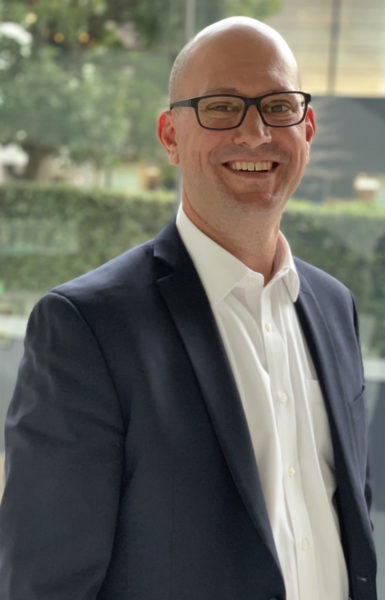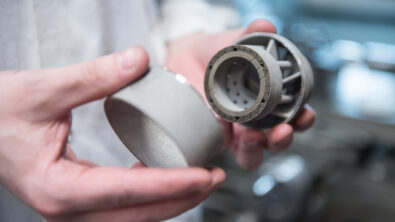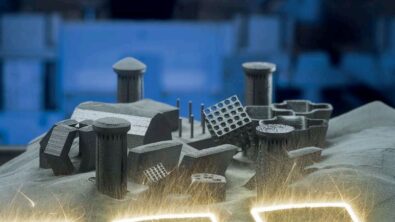Podcast series: Additive manufacturing – an industrial revolution (Part 1), the current landscape

Summary
There is nothing more exciting than being on the cutting edge of the next big breakthrough in technology. Additive Manufacturing has been referred to as a part of the Fourth Industrial Revolution, and we couldn’t agree more. The fast pace of innovation in 3D manufacturing means that things are changing constantly. Keeping you informed about the latest technology and emerging industry trends is what this podcast is all about.
No matter which aspect of additive manufacturing you might be involved in, we all want to know what that end product looks like. What are customers looking for, and how are they using this technology in a real-world sense? For many industries, additive manufacturing is an easy sell, and the benefits of the technology click instantly. For other industries, it’s up to us to demonstrate the benefits. We’ll discover what that process looks like, and how customers are responding.
In this episode, we talk to Aaron Frankel, the Vice President of the Additive Manufacturing Software Program at Siemens Digital Industry Software. He’s been a part of the team here for 23 years, working as an Application Engineer, a Product Manager, and he’s been involved in everything from marketing to design engineering, and worked as a manufacturer. Today, he talks to us about the current landscape of Additive Manufacturing.
Some Questions I Ask:
- Is the current Additive Manufacturing market meeting your expectations? (2:20)
- What are the strongest areas we’re seeing customer interest in additive manufacturing? (3:42)
- What needs to happen for companies to fully adopt additive? (6:37)
- What reasons are customers giving you as to why they are pursuing additive manufacturing? (16:58)
- How are customers using this technology? (18:54)
What You’ll Learn in This Episode:
- Frankel’s personal expectations for the industry (2:41)
- The “3 culprits” that are killing additive innovation (6:52)
- How Siemens is helping customers to recognize the benefits of additive manufacturing (10:46)
- Ways in which we collaborate with our ecosystem to industrialize additive (12:39)
- The three primary segments of those seeking out this technology (8:11)
Connect with Aaron Frankel:
There is a tremendous amount of untapped opportunity in the industrial manufacturing market, and expectations are high for additive manufacturing or 3D printing. However, with all the hype and advantages, there are some barriers to adopting this technology.
Additive manufacturing (AM), and its next-generation of innovative products, will drive the frontiers of performance and mass individualization. It will produce new flexible manufacturing capabilities and a more distributed manufacturing model to unlock new business infrastructures for companies. Yet, there are some fundamental capabilities and thinking in the industry that must shift to take advantage of its many positive attributes.

In this new series of additive manufacturing podcasts, we are joined by our special guest Aaron Frankel, vice president of Siemens additive manufacturing software program, discussing the landscape of the additive manufacturing market, including its current state, customer interest, product performance and hindrances to adopting this technology.
This first podcast will cover some of the current challenges and trends facing manufacturers and how these hurdles are driving a technological revolution. We will also address some possible barriers to adopting additive manufacturing technologies.Learn how many companies are leveraging AM to prototype new products to get it out of the digital world and get their hands on it. There is an increase in the prototyping of additive manufacturing applications that will be scaled into more extensive production operations, where additive manufacturing is producing parts and larger volumes for end-products.
Adopting additive manufacturing
To achieve full adoption of additive, the industry needs to contend with three culprits that are killing additive innovation. First, companies need to withstand a change-resistant culture. Sometimes this can reside in leadership. Leaders are often very enthusiastic about additive – even overly enthusiastic. It comes down to the program and the project leaders. They’re responsible for delivering the product to the market, and they have to manage the costs, meet the deadlines and can’t afford the risk of making wrong decisions. Moreover, they’ve got to have a process that works. So, we need to focus on helping companies change their culture and perspective of additive manufacturing.
Secondly, companies need to contend with inefficient project workflows. We observe many companies trying to get up-to-speed on their software and hardware, and sometimes they’re connecting multiple applications from different vendors. This scenario can be very painful to transfer data between these applications. Whenever a change occurs, the cost of making the change is magnified by disconnected applications that don’t talk to each other. This synopsis adds waste into additive projects.
The third culprit that can hinder additive adoption is contending with a lack of meaningful benefits. For example, when there’s a hiccup in the process, costs go up for a company’s time, and it can drag on, sometimes compromising product performance. When project benefits of additive don’t materialize, a decision-maker finds it more difficult to justify the organization’s advancement of additive manufacturing.
Therefore, to industrialize additive and help the industry adopt it, Siemens cannot do it alone. We have built a vast network of partners, both within Siemens businesses and across software and hardware industries. We focus on creating an ecosystem based on our customers’ needs, strategic endeavors and working closely, early in the process, with our customers to outline objectives. We align with our partner ecosystem to ensure proper alignment of our technology road maps.
We also work collaboratively to build opportunities for engaging on the business side to help go to the market and ramp up the customer’s additive operations. So, Siemens has a broad solution base, motion control and automation capability. We also include factory automation capabilities to develop our solutions and better connect and drive sophisticated 3D printing machinery. We ensure proper interfaces and capabilities within the software to define what the hardware is needing to produce repeatable quality parts.
Siemens Digital Industries Solutions Software, through its Xcelerator portfolio, provides a breadth of many capabilities, including collaborating with experts to overcome the challenges of adopting additive manufacturing to fully gain its benefits.
For more information:
Listen to the first podcast in this AM series to learn more about this engaging topic.
You can also access this podcast via Apple, Stitcher, Spotify, Castbox, TuneIn or Google.
About our experts:
Aaron Frankel is vice president of Siemens additive manufacturing software program. He has over 20 years of experience in the PLM software industry and has held various positions in engineering services, product management, and marketing – all focused on helping manufacturers take advantage of the latest digital design and manufacturing technology.
Ashley Eckhoff has a background in engineering and has been with Siemens for over 20 years in various capacities. He has spent the past few years deep-diving into additive manufacturing in both product design and marketing roles.



